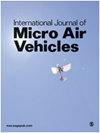Experimental study on the dynamic behaviour of drones designed for racing competitions
IF 1.6
4区 工程技术
Q2 ENGINEERING, AEROSPACE
引用次数: 3
Abstract
Drones designed for racing usually feature powerful miniaturised electronics embedded in fairly light and strong geometric composite structures. The main objective of this article is to analyse the behaviour of various models of racing drones and their geometrical structures (airframes). Two approaches have been made: (i) an analysis of the information collected by a set of speed and time sensors located on an indoor race track and using a statistical technique (box and whiskers diagram) and (ii) an analysis of the know-how (flight sensations) of a group of racing pilots using a series of technical interviews on the behaviour of their drones. By contrasting these approaches, it has been possible to validate numerically the effects of varying the arm angles, as well as lengths, on a test race track and relate the geometry of these structures to racing behaviour.竞赛用无人机动力特性试验研究
为比赛设计的无人机通常具有强大的微型电子设备,嵌入在相当轻而坚固的几何复合结构中。本文的主要目的是分析各种模型的竞速无人机及其几何结构(机身)的行为。采用了两种方法:(i)分析由室内赛道上的一组速度和时间传感器收集的信息,并使用统计技术(盒须图)和(ii)分析一组赛车飞行员的专有技术(飞行感觉),使用一系列技术访谈他们的无人机行为。通过对比这些方法,可以在测试赛道上验证不同臂角和长度的数值影响,并将这些结构的几何形状与赛车行为联系起来。
本文章由计算机程序翻译,如有差异,请以英文原文为准。
求助全文
约1分钟内获得全文
求助全文
来源期刊

International Journal of Micro Air Vehicles
ENGINEERING, AEROSPACE-
CiteScore
3.00
自引率
7.10%
发文量
13
审稿时长
>12 weeks
期刊介绍:
The role of the International Journal of Micro Air Vehicles is to provide the scientific and engineering community with a peer-reviewed open access journal dedicated to publishing high-quality technical articles summarizing both fundamental and applied research in the area of micro air vehicles.
 求助内容:
求助内容: 应助结果提醒方式:
应助结果提醒方式:


